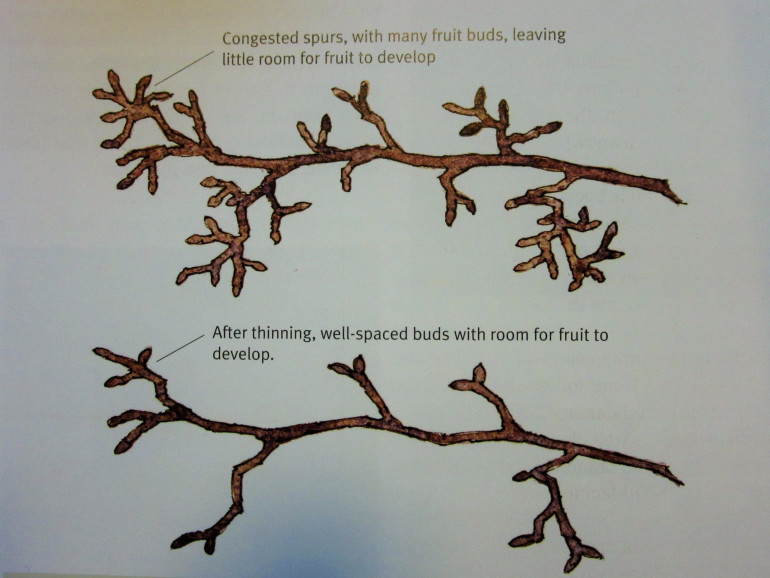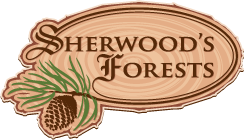
Dehorning Fruit Spurs
by Thean Pheh
Dehorning? No, I have not lose my marbles yet. This dehorning has nothing to do with animals. Yes, it has to do with apples and pears particularly those spur bearing types. In spring a mixed bud breaks and sends forth a few leaves before terminating with a cluster of flowers. These leaves are called spur leaves. At the axil of each spur leaf is a bud. As the little apple is growing; usually around the end of May in the Edmonton area; one of these will develop and grow, producing a couple of leaves before terminating into either a vegetative or mixed bud. This results in the formation of a spur to keep the fruiting point alive for many years. However in many spur varieties more than one bud develop in some years. Hence instead of a single bud spur we now a multiple bud spur. One may give rise to two, and two to three or four, and so on. This phenomenon gives rise to what is called a complicated spur. For lack of better terminology let us name these as secondary spurs.
Normally there are anywhere from 3 to 7 flowers to a mixed bud. Hence, if there are 4 secondary spurs in a complicated spur there will be 12 to 28 flowers in that complicated spur. No matter how many secondary spurs there are on a complicated spur there should only be an apple on each complicated spur. With many more fruits to thin out fruit thinning on complicated spurs is very laborious and time consuming. Commercial growers used to prune complicated spur to a single bud. This pruning is called dehorning. Dehorning will reduce labor required for fruit thinning. Fruits also get better exposure to the sun thereby enabling them to develop deeper skin color.
Although dehorning requires less labor than fruit thinning it is nonetheless also time consuming and labor intensive. With higher labor cost and shortages it is no longer economically viable for commercial producers to dehorn. Complicated spurs may also have gone down the path of the dodo in modern high density orchards where laterals are treated as replaceable fruiting scaffolds. But for us home gardeners, where standard or semi-standard trees are still the norm and tree shapes are important part of the landscape, complicated spurs are here to stay. Since time and cost are not determining factors we must weigh our options between dehorning and timely heavy flower and fruit thinning.
Dehorning is best done in spring as part of annual pruning. Let’s take an example of a complicated spur with four secondary spurs. I try to keep the shortest and closest spur/bud to the point of origin. Instead of sharing nutrients with three other buds, all the nutrients are now channelled to the reminding one. Hence dehorning increases the vigor of the retained spur. This may spur development of more than a bud and cause the return of complicated spur. Hence dehorning of spur may be an annual affair.
Instead of dehorning some growers prefer to thin all apples to retain only one on each complicated spur. After pollination the developing apples depend on food reserves stored in the vicinity of the spur to grow. Since this supply is rather small, regardless of how many secondary spurs a complicated spur has it must be treated as a simple spur. This is my modus
operandi. As soon as the flowers have elongated long enough for easy removal, I pick the strongest secondary spur and remove all flowers on the rest in that complicated spurs. With this the tree does not have to expend unnecessary energy to develop all the flowers. Energy thus saved goes directly to initiate and develop mixed buds for next year. My next step is to remove all except three flowers on the selected secondary spur. As soon as the retained flowers have bloom I start to thin out the apples, either end of May or first week of June in the Edmonton area. With this modus operandi I get bigger fruits and eliminate biennial fruiting or the well-known heavy and light fruiting cycle. There is a down side to this practice. Apples in complicated spurs are surrounded by too many leaves. This results in less colorful fruits.
Got something to say? Email me: sfinfo@sherwoods-forests.com
Interesting? Share this page.
Want to talk right now? Call me: (8 am to 8 pm only, please) 1-780-848-2548
Do not arrive unannounced. Phone for an appointment. Why? See Contact & Hours That same page gives our hours of operation.
Back to Top
Copyright © 2008 - 2021 S. G. Botsford
Sherwood's Forests is located about 75 km southwest of Edmonton, Alberta. Please refer to the map on our Contact page for directions.
